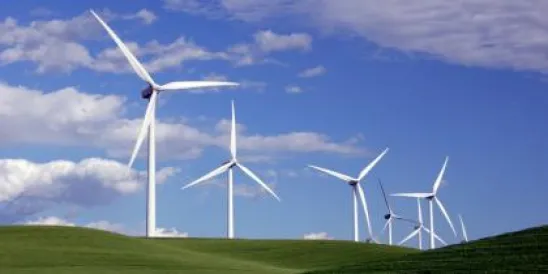While a signed power purchase agreement (PPA) with one or more utilities is a “must have” for a project developer to finance an offshore wind project in development, the challenges for offshore wind extend far beyond a financeable PPA. A significant part of the financing cost of a project is based on the perception of financial risk and project uncertainties. High project risk has contributed to high discount rates for financing offshore wind projects and justifiably, a cautious investment climate. Project risk can be broken down into the uncertainty surrounding regulatory and permitting issues (e.g., delays), the risks associated with construction and installation, and the operational risks that are associated with accurate energy production and long-term reliability. Risk and uncertainty may dissipate as the offshore wind industry matures, but today the process remains immature.
Oddly, what is not so immature in the US is onshore wind. Today the US has more wind power installed than any other country in the world bar China, and wind is now the largest source of renewable energy in the US, but again, we are talking onshore wind, and the US has been very slow to take up the challenge of offshore wind. Why? Because the success of onshore wind does not translate so easily offshore.
That said, most of the offshore wind turbines in operation are marinized versions of proven land-based turbine designs with upgraded electrical systems and corrosion systems, which are placed on free-standing concrete gravity bases or steel monopile foundations. As water deepens, the decoupling of land-based and offshore technologies also increases, but new technologies are being created or adapted from the oil and gas industry, including jacket substructures and multi-pile foundations, which also extend to the sea floor.

Ultimately, free floating structures will allow the US to fully mine its offshore wind recourses, but those remain in early development. The development of floating wind technology will dictate a new set of wind turbine design specifications to handle the additional hydrodynamic forces (waves) and aerodynamic forces (wind), affecting the buoyancy stability of top heavy floating structures. The incentives to “go deeper” are there, as free floating structures in deep water also mean:
-
Higher wind speeds and sustained winds: Greater energy capture over deeper waters
-
Reduced impacts on human activities and environmental ecosystems
-
Tripling the U.S. resource potential past 60 m in depth.

So why is a financeable PPA not a panacea for offshore wind? Short answer: Offshore wind faces higher costs than land-based wind, and greater uncertainty. Currently, capital costs for offshore wind projects are nearly double those for land-based wind projects. These higher capital requirements accrue from the higher costs of the “marinization” of wind turbines, offshore turbine support structures, offshore electrical infrastructure construction, the high cost of building at sea, operations and maintenance costs at sea (including higher cost for equipment warranties at sea) and a decommissioning contingency at the end of infrastructure life. Offshore wind projects in the US must overcome a quagmire of state and federal regulations, coupled with “not in my backyard” concerns that have been “the cause of death” for many early projects along the Atlantic seaboard. An additional element to be considered is the initial one-time cost associated with developing the necessary infrastructure to support what may become a very large offshore industry, including the costs for fabricating numerous specialized vessels, upgrading ports and harbors, establishing manufacturing facilities, and creating and administering workforce training programs. Early projects will also necessarily bear the brunt of these costs, as additional investments will follow in time. With tax incentives currently expiring in 2020, there are clearly pros and cons to being the “early bird,” as reflected in the following case study.
Case Study: Vineyard Wind (15 miles south of Martha's Vineyard, offshore Massachusetts).
Vineyard Wind had originally planned to financially close on its project and begin onshore construction work in 2019, put the first turbine into the seabed in 2021 and have the 84-turbine wind farm generating electricity in 2022. Fast forward to today, all of those dates will need to be extended.
The Project and its PPAs:
With 800 MW of installed capacity and an investment of almost $3 billion dollars, Vineyard Wind is the largest wind farm currently being developed in the United States. Vineyard Wind LLC signed two PPAs with Massachusetts electric distribution companies in July 2018 for a combined 800 MW of offshore wind capacity expected to become operational in 2022 and 2023, respectively. While difficult to calculate with certainty, after adjusting for contract type, transmission, policy, and access to external revenue (tax credits), the Vineyard Wind project has an all-in price of $98/MWh.
The price of an individual PPA is very different from the cost of generation for an offshore wind project. The cost of generation is generally determined as a levelized cost of energy (LCOE) calculation that includes the initial installed capital cost (ICC) as well as operations and maintenance (O&M) costs, the cost of financing, amount of energy to be generated, long-term system reliability, and decommissioning costs. Renewable energy projects receive subsidies from the federal government and include attributes such as renewable energy credits (RECs) and the value of capacity credits. These attributes produce additional revenue streams and allow project owners to sell output below the actual cost of generation. These benefits are set to expire at the end of 2020, but Vineyard Wind is entitled to RECs, based on its start date(s).
Remaining Challenges for the Project:
With all that is going for Vineyard Wind, the project is still not out of the woods. It was recently announced by the project developers that the Department of Interior indicated the Final Environmental Impact Statement (FEIS) for the Vineyard Wind I project will be published later than what was previously anticipated, and delay was to be expected. By all accounts, however, Vineyard Wind will press on, and is expected to find itself with financing, but at what price? It should be pointed out that Vineyard Wind has two strong and experienced project developers, as it is essentially a joint venture between Iberdrola of Spain (operating under the name Avangrid Renewables) and by Copenhagen Infrastructure Partners (CIP). What Vineyard Wind may lack in LCOE, it can overcome with strong and experienced project developers.
At a presumed LCOE below $98/MWh, the financial model for Vineyard Wind can justify a financing, but as indicated, the ICC of Vineyard Wind, while an obstacle, is not the primary risk. The largest fraction of risk and uncertainty is associated with the construction, installation, operation, and decommissioning phases of the project, and those risks can be mitigated by experienced offshore wind developers like Iberdrola and CIP.
The Future for Offshore Wind:
In summary, offshore wind is both costly and “new” in the US, and continues to struggle in a regulatory environment that can best be described as “shifting.” Past experience with land-based wind and solar has demonstrated that technologies can advance at a pace that is greater than expected, increasing output and efficiencies, and bringing down prices per MWh of renewable generation. The levelized cost of energy (LCOE) for offshore wind will remain high for the short term (vis-à-vis hydrocarbon generation), but as climate change factors proliferate and should carbon emissions in the future come with a monetized cost ($), the LCOE of offshore wind will narrow the gap on hydrocarbon resources. As offshore wind projects get bigger, the installed cost of capital will get bigger, but the cost of fuel will always remain the same: zero, thereby giving consistent support to its LCOE. While technological advancements in offshore wind will accelerate in the next few decades, lenders abhor technology risk. It is the proverbial double-edged sword: Offshore wind will presumably witness some of the greatest technology advancements in the foreseeable future, and therefore, face new and uncertain technology risks for the foreseeable future.





 />i
/>i

